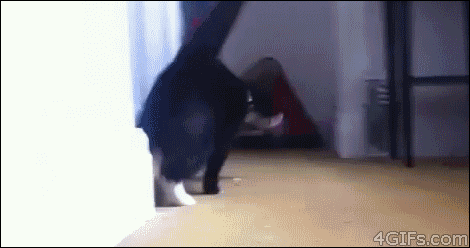Winter v. DC Comics, 69 P.3d 473 (Cal. 2003) expanded on the California rule: “[a]n artist depicting a celebrity must contribute something more than a ‘merely trivial’ variation, [but must create] something recognizably ‘his own’ in order to qualify for legal protection.” ETW v. Jireh decided that a painting was transformative because it was a collage of Tiger Woods with other golf greats.
Adriennemeddock
Shared posts
Long, unhappy post on Hart v. EA
Winter v. DC Comics, 69 P.3d 473 (Cal. 2003) expanded on the California rule: “[a]n artist depicting a celebrity must contribute something more than a ‘merely trivial’ variation, [but must create] something recognizably ‘his own’ in order to qualify for legal protection.” ETW v. Jireh decided that a painting was transformative because it was a collage of Tiger Woods with other golf greats.
OK, Sold On One Condition…
Does it come with the new Kitteh Positioning Satellite system? (KPS.)

From The Fluffington Post.
Filed under: Uncategorized Tagged: kittehs
LMFAO Takes Ex-Manager to the California Labor Commissioner (Exclusive)
Adriennemeddockunlicensed agent....

With possibly $7 million on the line, a trial begins on Monday where the successful electronic duo attempts to demonstrate that Rene McLean acted as an unlicensed agent.
Surnames as trade marks: an Indian perspective
One's name has been regarded as one's most characteristic possession, which differentiates a person from all other persons and enables him to be known. People are differentiated on the basis of their surnames and goods are identified by their distinctive trade marks. Trade marks which, by association, connote quality are an asset, but trade marks are also a liability because the owner stakes his reputation for better or for worse on his goods.
The right to use one's own name as a trade name, trade mark or service is not absolute. There has been litigation for trade mark infringement resulting from the use of personal name or surname trade marks as the trade mark significance of a surname may come to dominate the surname significance over time through long and exclusive use by the trade mark owner. The basic problem with registering surnames is that they are generally objectionable, per se, on the ground that they are not distinctive and in order to be distinctive it is clear that a mark must be different from other marks used upon or in connection with the same or similar goods.
In this article, I will not only describe the Indian position on the use of surnames as trade marks but also briefly describe the position in United States and Europe.
Nosal Convicted of Computer Fraud and Abuse Act Crime Despite His Ninth Circuit Win – US v. Nosal
AdriennemeddockThis is the case I wrote up for 2011 IP Annual
[Post by Venkat Balasubramani, with a comment from Eric]
US v. Nosal, CR 08-0237 EMC (N.D. Cal. Mar. 12, 2013) (.pdf, denying motion to dismiss)
US v. Nosal, a case that spawned two Ninth Circuit opinions and that’s sure to involve more, just concluded at the trial court level with Nosal being convicted on charges of violating the Computer Fraud and Abuse Act. (See coverage from David Kravets here (“Hacking Trial Devoid of Hacking Awaits Jury Verdict”) and Vanessa Blum here (“Nosal Found Guilty in Trade Secret Case”.)
Judge Patel originally dismissed several of the counts that alleged the misuse of information that were accessed by individuals who were authorized to access the information. Although the 9th Circuit initially disagreed, an en banc panel agreed with this approach, ruling that criminality should not turn on the person’s intent in accessing information or employer policies. The key question is whether the defendant is authorized to access the information in question at all. Since the dismissed counts alleged people accessed information they were otherwise authorized to access but misused this information, these counts were out.
But this left some remaining counts, which involved access via password sharing. Nosal argued that the 9th Circuit’s en banc opinion in Nosal precluded these claims as well because they did not involve any “hacking” in the traditional sense, but the district court (now Judge Chen) disagreed. In a March 12th order, he said that the 9th Circuit’s discussion of the CFAA as anti-hacking was only relevant to discuss the general purposes behind the CFAA and not something by which the court intended to limit the statute. In any event, he noted that a password is a basic technological barrier to access and using someone else’s password is as much a violation of the CFAA as is breaking the password. Nosal also argued by analogy to off-line trespass, saying that accessing an office with someone else’s key is not trespass, but the court doesn’t buy this argument.
The court also addressed the parties’ argument over whether “access” for purposes of the CFAA is the act of initially logging on, or encompasses ongoing use. Defendant argued that access just involves logging on, and if someone logged on with their own password, then the access is not unauthorized. The court rejects this interpretation, saying that the scenario as alleged by the government is that someone logged on using their credentials, then handed over the computer to the person who was unauthorized who then conducted searches on the database. The court says this is functionally no different from just handing the password over and letting the other person access the database. (The court notes that it need not address the issue of whether looking over someone’s shoulder and “accessing” information falls under the statute.)
[As a sidenote, a federal district court in New York recently joined the 9th Circuit in rejecting the broader interpretation of the CFAA. Interestingly, this case also involved a recruiting business.]
__
It's interesting that with all the hand-wringing generated by the 9th Circuit's opinion, Nosal was convicted anyway! Eric has made this point previously, but it seems like there are always avenues open to employers to go after people who start competing businesses. Here, there was even a more narrower CFAA claim that was available after several of the claims were nuked by the 9th Circuit. Even with these claims gone, there are still plenty of claims, at least on the civil side.
Judge Chen's order, which is sure to be revisited in post-trial motions and in an appeal, grapples with the interesting issue of whether access by proxy violates the statute. Nosal's argument--that the initial access which is effected by a person is authorized and this is all that matters--is an interesting one, but one that is unlikely to get much traction in the 9th Circuit. Still, it has some appeal, since the line between logging on and letting someone access and logging on accessing the information and providing it to someone is legally thin. (It's also worth noting that this case should serve as a warning to those who share passwords.)
_______
Eric's Comment. This case baffles me. Did Nosal do something wrong? Yes, undoubtedly. Did he do something criminal? I'm not sure. Did he violate the Computer Fraud & Abuse Act? No, and it's not even close. At most, Nosal encouraged or induced a CFAA violation, but as I understand the facts, he didn't commit the CFAA violation directly. As Venkat notes--and as I outlined in my Forbes article on the CFAA--a variety of legal doctrines would have made Nosal pay for his choices. Contorting the CFAA to apply to him was unnecessary, and it's disquieting for the rest of us.
_______
Related posts:
Ex-Employee's Access/Misuse of Employer Files States CFAA Claim -- Weingand v. Harland Financial
Comments on the Ninth Circuit's En Banc Ruling in U.S. v. Nosal
Facebook Gets Decisive Win Against Pseudo-Competitor Power Ventures
Court Finds That the Value of Bartered-For Services Constitutes Loss Under the Computer Fraud and Abuse Act -- Animators at Law v. Capital Legal Solutions
No Computer Fraud and Abuse Act Violation for Access of Facebook and Personal Email by Employee -- Lee v. PMSI
9th Cir: Access of Computer in Violation of Employer's Use Policy Violates Computer Fraud and Abuse Act -- US v. Nosal (original panel opinion, vacated on rehearing)
Lori Drew Guilty of 3 Misdemeanor Violations of the Computer Fraud & Abuse Act
Appropriation Artist Richard Prince Prevails Against Photographer at Appeals Court

In an important copyright ruling, the Second Circuit rules that most of the artist's use of Patrick Cariou's photographs was transformative.
Lawsuit Claims Paramount Stole 'Paranormal Activity 4' Ideas from Pitch Meeting
AdriennemeddockEnt Law

Filmmaker Michael Costanza claims the studio and two producers used concepts he submitted in 2010 for the hit 2012 horror movie
April 2013
A Fiery Brazilian Beauty
The Cloud of the Month for April was photographed over Brazil by Pilot Ron Engels from the flight deck, en route from Amsterdam to Lima. It shows a majestic vista of castle-like towering Cumulus and Cumulonimbus clouds extending for miles ahead. A pilot must plot his route carefully to find a safe passage through these cloudy battlements. You might think that, unlike real castle turrets, the ephemeral clouds wouldn’t present many problems for an airliner, but clouds like these have to be avoided at all costs. They contain violent up- and downdrafts of air that can flip a plane like a pancake. As the author G. K. Chesterton wrote, “There are no rules of architecture for a castle in the clouds”.
Photograph © Ron Engels.
First Myriad reactions
Lyle will have a full argument analysis, and Amy will follow in Plain English, but I wanted to put something up with my initial reactions to the just-concluded oral argument.
It seems clear that the Court has grave doubts about holding that isolated DNA segments are themselves patentable. At the same time, it does not want to inhibit patents that truly add something new or identify a valuable use. So I expect a narrow ruling by a substantial majority that isolated DNA itself is patent ineligible. But the Court will hold or suggest that cDNA, as well as use or process patents involving isolated DNA, are patent eligible. The question in individual cases will be whether those further patents are invalid because they are obvious.
Here is Bloomberg’s first report, as well.
In association with Bloomberg Law
5th Annual Trademark Scholars' Roundtable
Adriennemeddockgood notes on ulk tm history
Session 1: Conceptual Questions About Registration
Mark Janis: conversation about registration is not often academic, and that means there’s a lot of opportunity to investigate high-level conceptual issues (not just questions about the TMEP): systemic design choices, which eventually manifest at the level of the TMEP. Conversation in the US is rather pedestrian; we have a lot to learn from other systems.
Graeme Dinwoodie: not a burning issue like TM use, but underexplored. Outside the US registration a significant part of practice, and of international policy discussion. Why does registration dominate that discussion/debate at the international level? Seen as principal defining characteristic of national regimes: use-based or registration-based. Doesn’t even teach registration in the US until halfway through, but in the UK/Europe that’s where he starts.
But has found the differences overstated. Intent to use in the US: constructive use, complete modification. In EU, most countries have grounds for opposition that take into account use-based rights. But we may also understate the system’s effect on other features of the system—in some ways a proxy for a passing off claim (for unregistered marks)—should we have a narrow set of rights from registration that are more property-oriented, and then §43(a) for passing off? Registration line might be a line between two different types of claims, on the one hand representing slam-dunk uncontestable property rights and others at the margins. EU: one of the challenges of EU for Court of Justice has been to accommodate historically use-based and varying degrees of registration-based systems. Playing with reality v. paper rights to compromise reflecting different systems.
Mark McKenna: also teaches that registration is not fundamentally the point of the system. Why is that so? Three overlapping ambivalences in US law. (1) The extent to which we want the TM system to be federal as opposed to state law. (2) The extent to which we want it to be statutory rather than common law. (3) The extent to which we can sensibly think about TM law as distinct from unfair competition.
1870: first registration system; struck down. 1881: new system available only to marks used in foreign trade/trade with Indian tribes. The registration system has always been a carrot rather than a stick. Initially the carrot was a federal cause of action, available only for registered marks. That carrot has been chewed up now. However, one thing that did was distinguish TM from unfair competition (the cause of action available under state law for unregistered marks). Prior to Erie, that didn’t matter a lot as a matter of substance—registration gives you a federal cause of action, but you can just vindicate your existing claims—the right is “procedural.” Post-Erie, the courts were confused about what that meant; the substance must be coming from state law.
Registration wasn’t widely used when commerce was more limited; the benefit of rights beyond a specific location of use wasn’t tremendously important to most people. By the time of the Lanham Act, some desire for more rights, but the design choice was still to provide a carrot. Subject matter: in 1905 and even 1946—had in mind a much narrower set of things, technical TMs, not trade dress/product configuration. That was all left to unfair competition.
Post-Lanham Act, substantial broadening of §43(a) begins to sweep this into the federal level. Now a registration doesn’t mean much because you can get so much through §43(a). American law has lost the ability to conceive of unfair competition as distinct from §43(a), and that’s a loss. Badly undertheorized, but one reason is that it’s a jack of all trades. Though we may call §43(a) claims unfair competition, because they’re subject to all the same rules as registered TMs, we don’t really think about the differences.
Unfair competition law didn’t prevent copying of product configuration, but did require labeling. There might be gains from rethinking subject matter of TM law and non-subject matter.
Lionel Bently: UK history. What is now TM law was found in various places—statutory provisions built around particular trades. E.g., from the 17th c. there was local legislation relating to marks used on cutlery, knives, etc. 1720s, act gave protection to marks woven into or printed on linens. 1813, act relating to counterfeiting marks on gun barrels. Etc. Alongside that there were provisions of the emerging common law and equitable rules that eventually became to be seen as passing off.
Traders seek registration system. 1860s: bills introduced to allow registration/criminalize misdescriptions in trade. Outcome: no registration, but criminalizing misdescription in trade, not just labeling source but quantity/quality—consumer protection indirectly protecting traders. Traders continued to lobby for registration system. 1875: registration enacted (after the US and British colonies). Colonial experience may have helped confidence in operation of registration.
Treaties premised on the notion of reciprocity. Foreign countries wouldn’t recognize Britain’s scattered protection for purposes of reciprocity—or at least British traders believed this, though he’s never seen evidence that foreign countries declined to provide reciprocity on this basis. Registration is therefore linked from the start to international protection. That may explain US’s disinterest; many US traders wouldn’t have cared at the time. (McKenna: most worried about expanding markets in the US since there was so much room to grow there.)
Expensive for traders to establish rights each time; wanted easy recognition, and registration seemed a good way. Note that registration was being proposed for lots of things at the time—land, design, copyright for works of fine art. Thinking in terms of registration was not a strange move.
Problems: questions of definition. Personal names were most common marks, but what would it mean to register a surname? Excluding other people with the same surname? A disconnect between the feeling that a trader should be able to use their own name and a registration system that would include names. Same too with indications that goods came from a particular place, also common.
Also seen as potential vehicle for fraud: registration could allow transferability of TMs, which would enable deception of consumers.
Another objection: would the system change the nature of what was protected? If the registration system protected different things from what was being used, that would cause difficulties. Louboutin case in the US shows problems with figuring out what the representation in the registration actually protects.
1875 Act: registration was only permitted in relation to narrow category of subject matter. Words/names not initially registrable apart from where they’d already been used/acquired a reputation—going forward, no registration of names/words, but rather symbols and devices. The act didn’t define the rights given to a registrant, until 1905—just operated as constructive use that could be the basis for a common law action.
Relationship with common law was unclear. 1875-77: commentaries assumed that you couldn’t rely on the common law if it was registrable but not registered. By 1905 dual system was accepted.
18,000 registrations by 1880. In particular fields there were real problems, such as marks relating to cotton where a separate system was set up for determining validity: 40,000 applications, with only 10% registered. Move from different trades to centralized regime, and wasn’t ready for that and had to go back to the trade!
McKenna: US may be free riding—no struggle with what may be registered. Early acts just say the owner of a TM can register it; no attempt to define what a TM is, though people seem to think they understand that. Only later does terminology of technical TMs develop. Basically the idea is inherent distinctiveness, but no struggle to reach that conclusion. Never any question that state protection is also available for registrable marks.
Jessica Litman: in hearings as early as 1910, you do have TM lawyers fighting over trade names being included as TMs. But that’s post 1905.
Bob Bone: separate provision for descriptive marks after that.
McKenna: trying to map timeframe: up to the 1905 act, the terminology is starting to surface but not making its way into the statutory discussion.
Stacey Dogan: Is TM supposed to protect consumer meaning, or to protect producers and provide property-like system of metes and bounds? Thinking conceptually about reasons for use-based v. registration-based regimes; costs and benefits. Blending is worst of all possible worlds.
If consumer protection is our goal, TMs should be defined by consumer recognition (including geography). Practical and error-cost reasons to provide rights that don’t perfectly correlate with consumer expectations: inherently distinctive marks can be protected before acquiring brand significance in consumers’ minds. But use based rights do resonate with the economic approach to TM protection and suggest a limited scope of protection. Registration offers priority or just affirms the existence of use-based rights.
Notice is a big benefit of registration, at least in theory, especially as producers expand into new markets and may have trouble determining what rights exist. Maybe it should be required for certain types of marks. But these advantages require the registry to be an accurate catalog of who has which legal rights. Today’s blended regime means that a registry search isn’t a full clearance.
Warehousing/gamesmanship. This problem can be avoided through proof of use before the registration vests and if the rights are limited strictly to the nature of the use that’s specified in the application. If we insist that parties only register marks that they have a good faith intent to use and the rights don’t vest until use, and then only to the uses made, problems are less costly.
Pragmatic reason for not having registration-only: not everyone has resources/sophistication to register. But does this protection have to be the same as that provided to registered marks? Perhaps only protect against passing off.
What if we required registration for trade dress? This is an area where notice is the most problematic for understanding what copying is ok. Competition concerns are quite significant. Appeal to having some level of review, registration, and notice w/r/t those kinds of marks. Whatever we say about Louboutin, one interesting thing is that the court did limit the registration to the mark that was actually used. Could take the further step to say that when the marks are registered in that configuration, the scope ought to be more limited as well.
Litman: could argue that they limited it to the specimen of use, since the description didn’t require contrast.
Dogan: if notice is a benefit, could harness registration for areas where notice is a special problem.
Dinwoodie: essentially preempt a common law action with respect to that subject matter.
Dogan: right.
Dinwoodie: flip the Louboutin facts: where the mark said “contrast” but in fact the use went beyond contrast—would you preclude a case?
McKenna/Dogan: yes.
McGeveran: require use to get the meaning that leads to the registration, but then protect only registered marks?
Dogan: yes: registration confirms source identifying meaning and formalizes it.
Bone: if we’re worried about consumer confusion, it seems somewhat arbitrary to limit protection except for the benefits of avoiding too broad protection. But can we rely on the PTO to strike an appropriate balance between avoiding anticompetitive effects and protecting against consumer confusion. Once the applicant understands the limits, the applicant will make very broad claims for protection. Like an overbroad patent application; the examiner will have to narrow it—can we trust in that.
Dogan: fair point.
Janis: lessons from patent law: when you put a lot of pressure on the registration document, you get arguments to a court that the PTO didn’t strike the right balance, so you need a doctrine of equivalents or the like. There needs to be a mechanism to deal with scope later, and the erosion of notice therefrom.
Dogan: early version of the idea! Basic question is whether we can get some of the benefits of registration and make them real w/r/t certain types of marks.
Dinwoodie: existence of other systems do some of the work, design patent/copyright—this is what made the Court comfortable in Dastar, Wal-Mart, and Traffix. If you make everything strong, then all rights will be strong; a weak safety valve might be better, including a weak cause of action for unfair competition. Forcing into single strong property regime is difficult.
Dogan: would need more robust review; formalize Traffix and say you can register incidental/arbitrary (court unfortunately also says “ornamental”).
McKenna: registration systems are created at a moment when the scope of rights is very narrow—very similar mark for very similar goods/services. So we need to consider registration and scope—registration is more worrisome when what counts as infringement expands. We should think about scope.
The more done in registration, the more pressure on examination. Except for silly incontestability, he doesn’t care if it’s registered; presumption of validity doesn’t mean as much in TM as in patent. (I think I disagree with this.)
Marshall Leaffer: we don’t want to overburden the registration system. Unfair competition notions folded into registration create questions of description. TM office doesn’t want to have to describe these things.
We do live in a fairly harmonized world. So we need to understand how it will be integrated worldwide. If we throw too much in, our assumptions will be undermined.
Jeremy Sheff: On the importance of structuring examination process: compare patents. People believe that most patents aren’t valuable; the market will figure that out and courts will deal with it. The reason that doesn’t even arguably work for TM is incontestability. If the examination process fails us because of institutional pressures it may take longer to determine which are valuable; we don’t have a comparable way for reassessing validity on descriptiveness.
Dogan: but functionality is usually the biggest problem for trade dress.
Sheff: but there are other issues.
Leaffer: maintenance fees? Increase them! Make people reveal valuations.
Dogan: just a thought experiment. Other general questions have been raised about the values of registration v. use based systems.
Sheff: if you killed incontestability, the problem would go away, but other problems of competition remain from the examination process.
Dogan: they are getting registration/incontestability now when they want to.
Janis: without incontestability, we’d shift to debating presumption of validity, which would become more meaningful.
Litman: updating a casebook every year for 20 years, so she doesn’t see in topic terms but in year to year terms. When Two Pesos came out, she thought no one would bother to register trade dress. But unquestionably in 5-10 years is that litigated cases generating opinions involving registered trade dress swamp the number of unregistered trade dress cases.
(1) PTO has loosened up a lot on registering trade dress. (2) People looking for international protection down the line get nothing from use-based rights. Sometimes broad trade dress claims have gotten through the PTO. So a registration requirement is worth thinking about.
McGeveran: notice. Trying to puzzle through how notice works in a meaningful way. Incentivizing fighting it out at the beginning, but only if you’re a sophisticated competitor. You may not be able to wait and see. Good for clarity, but bad for disputes generated without need? Also, what about people who don’t know that they’ll have a problem (small, not yet existing competitors). What is the effect of the registration? If you start to get too concerned about those people, then you immediately move to whittling away at the significance of the registration.
Beebe: similar to copyright, where the background assumption of early opinions was that only registration granted rights—so narrow subject matter underlay formation of rights that we now take for granted as applying to anything that is fixed.
Reference to priority: Main reason to register in US is nationwide priority—constructive notice/constructive use.
Mike Grynberg: registration takes a fact intensive inquiry and resolves it at the administrative level. Familiar arguments about expertise/regulatory capture. Trying to get an information signal that people can rely on. We don’t trust the PTO, so we need either a limit on the kinds of rights registration gives or aggressive judicial oversight. That’s not inconsistent with thinking that the PTO’s information signal is worthwhile. You might need to clear the hurdle of the PTO as a necessary but not sufficient condition for protection.
Dogan: functionality is key here—how do we feel about oversight of PTO decisions. Also secondary meaning, to some extent. Supreme Court has been good on functionality lately, and most lower courts are doing ok, except on aesthetic functionality. This remains alive even after incontestability. Could adjust the presumptions and make this kind of system for trade dress be pure notice. Judges could take a more aggressive approach to reviewing the eligibility questions.
Dinwoodie: like a deposit system?
Dogan: like copyright, maybe.
McKenna: all of us coalesce around concerns over trade dress, not trademark. Would a mandatory registration system confined to traditional subject matter be a good idea? It’s not just functionality. One of the problems w/trade dress is just how amorphous and undefined the concept is. Look at what people claim—“everything about us” is our trade dress. The PTO would have to be able to decide something about claim scope. Whether you’re claiming too broadly or not. They don’t do that—they think only relationally compared to existing marks. But that’s not enough; the fact that other Mexican restaurants have festive atmospheres (Two Pesos) doesn’t come into the analysis. (Of course Two Pesos was unregistered!)
Ponce de Leon Hotel: 1897
 St. Augustine, Florida, circa 1897. "Ponce de Leon Hotel -- Front view and entrance." Railroad magnate Henry Flagler's coquina confection is known today as Flagler College. 5x8 glass negative by William Henry Jackson. View full size.
St. Augustine, Florida, circa 1897. "Ponce de Leon Hotel -- Front view and entrance." Railroad magnate Henry Flagler's coquina confection is known today as Flagler College. 5x8 glass negative by William Henry Jackson. View full size.
OMGPONIES!!!!1!1! (We Call This Look “The Farrah”)
AdriennemeddockI am not sure what happens when I hit share in the old reader.
Positively Angelic, no?

The Firdinator sent this one in.
Filed under: Uncategorized Tagged: Horses, OMGponies
Congressman Faleomavaega Introduces Bill To Cancel REDSKINS Registrations

According to a briefing paper distributed to legislators, there are currently six trademark registrations and five pending trademark applications that would be affected by the bill. [Read more here]
Read comments and post your comment here.
I'll Remove More Than an Ear
Lol by: Unknown (via Sagittariusgalley)
Tagged: grumpycat , ear , painting , Vincent van Gogh Share on Facebook













